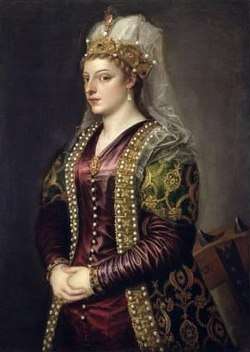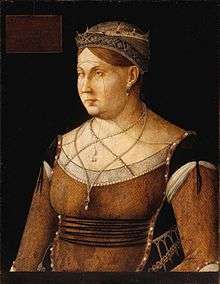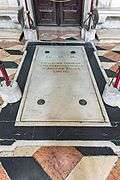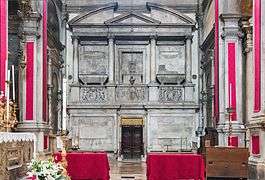Catherine Cornaro
Catherine Cornaro (Greek: Αικατερίνη Κορνάρο, Venetian: Catarina Corner) (25 November 1454 – 10 July 1510) was the last monarch of the Kingdom of Cyprus. She was queen consort of Cyprus by marriage to James II of Cyprus, regent of Cyprus during the minority of her son James III of Cyprus in 1473–1474, and finally queen regnant of Cyprus. She reigned from 26 August 1474 to 26 February 1489 and was declared a "Daughter of Saint Mark" in order that the Republic of Venice could claim control of Cyprus after the death of her husband, James II.[1]
| Catherine Cornaro | |
|---|---|
 Portrait of Caterina Cornaro by Titian, 1542 | |
| Queen of Cyprus | |
| Reign | 26 August 1474 – 26 February 1489 |
| Predecessor | James III |
| Queen consort of Cyprus | |
| Reign | November 1472 - 10 July 1473 |
| Born | 25 November 1454 Venice, Republic of Venice |
| Died | 10 July 1510 (aged 55) Venice |
| Spouse | James II of Cyprus |
| Issue | James III of Cyprus |
| House | Cornaro |
| Father | Marco Cornaro |
| Mother | Fiorenza Crispo |
Life
Catherine was a daughter of Venetian Nobile Huomo Marco Cornaro (December 1406 – 1 August 1479), Cavaliere del Sacro Romano Impero (Knight of the Holy Roman Empire) and Patrizio Veneto (Patrician of Venice), by his wife Fiorenza Crispo. Her father was the great-grandson of Marco Cornaro, Doge of Venice from 1365 to 1368.[2] She was the younger sister of the Nobil Huomo Giorgio Cornaro (1452 – 31 July 1527), "Padre della Patria" and Knight of the Holy Roman Empire.[3] The Cornaro family had produced four Doges. Her family had long associations with Cyprus, especially with regard to trade and commerce. In the Episkopi area, in the Limassol District, the Cornaro family administered various sugar mills and exported Cypriot products to Venice.[4][5][6]
Catherine's mother, Fiorenza Crispo, was a daughter of Nicholas Crispo, Lord of Syros. Although Crispo is said to have married two women, Fiorenza's mother is most likely the daughter of Jacopo of Lesbos; according to his own correspondence, Niccolò was a son-in-law of Jacopo of Lesbos.[7] While an account by Caterino Zeno dated to 1474 is often quoted as naming a second wife for Nicholas Crispo, Eudokia-Valenza of Trebizond, a reported daughter of John IV of Trebizond and an unnamed daughter of King Alexander I of Georgia, Michel Kuršanskis has proven that this woman never existed.[8]

Catherine was painted by Dürer, Titian, Bellini and Giorgione.[9]
Queen consort
In 1468, James II of Cyprus, otherwise known as James the Bastard, became King of Cyprus. In 1468 he chose Caterina for his wife and Queen consort of the Kingdom of Cyprus. The King's choice was extremely pleasing to the Republic of Venice as it could henceforth secure the commercial rights and other privileges of Venice in Cyprus. They married in Venice on 30 July 1468 by proxy when she was 14 years old. She finally set sail to Cyprus in November 1472 and married James in person at Famagusta.[10]
Reign
James died soon after the wedding due to a sudden illness and, according to his will, Caterina, who at the time was pregnant, acted as regent. She became monarch when their infant son James died in August 1474 before his first birthday, probably from illness even if it was rumored that he had been poisoned by Venice or Charlotte's partisans.[11] The kingdom had long since declined, and had been a tributary state of the Mameluks since 1426. Under Caterina, who ruled Cyprus from 1474 to 1489, the island was controlled by Venetian merchants, and on 14 March 1489 she was forced to abdicate and sell the administration of the country to the Republic of Venice.[12]
According to George Boustronios, "on 15 February 1489 the queen exited from Nicosia in order to go to Famagusta, to leave [Cyprus]. And when she went on horseback wearing a black silken cloak, with all the ladies and the knights in her company [...] Her eyes, moreover did not cease to shed tears throughout the procession. The people likewise shed many tears."[13]
In February 1489, the Venetian government persuaded Catherine to cede her rights as ruler of Cyprus to the Doge of Venice—and by extension the Venetian government as a whole—as she had no heir.[14]
Later life
The last Crusader state became a colony of Venice, and as compensation, Catherine was allowed to retain the title of Queen and was made Lady of Asolo, a county on the Terraferma[15] of the Republic of Venice in the Veneto region, in 1489. Asolo soon gained a reputation as a court of literary and artistic distinction, mainly as a result of it being the fictitious setting for Pietro Bembo's platonic dialogues on love, Gli Asolani. Caterina died in Venice in 1510.[16]
 Her grave
Her grave Her funeral monument
Her funeral monument
Legacy
A libretto based on her life by Jules-Henri Vernoy de Saint-Georges formed the basis of the operas Catharina Cornaro (1841) by Franz Lachner,[17] La reine de Chypre (1841) by Fromental Halévy,[18] and Caterina Cornaro (1844) by Gaetano Donizetti.[19]
The Cornaro Institute, a charitable organisation founded by the artist Stass Paraskos in the city of Larnaca, for the promotion of art and other culture,[20] memorialised her name in Cyprus, prior to its closure by Larnaca Municipality in 2017.
Also in Cyprus, in October 2011, the Cyprus Antiquities Department announced Caterina Cornaro's partially ruined summer palace in Potamia would be renovated in a one million euro restoration project, becoming a cultural centre.[21][22] Work is on going in Potamia by craftsmen from the Department of Antiquities to renovate Caterina Cornaro's Summer Palace with about half now completed.
References
- Wills, Garry. Venice, Lion City (New York, Simon and Schuster, 2001), 136.
- Cawley, Charles (12 June 2011), Profile of Marco Cornaro and his children, Medieval Lands database, Foundation for Medieval Genealogy, retrieved 16 December 2011,
- Geneagraphie - Families all over the world
- McNeill, William H. (15 November 2009). Venice: The Hinge of Europe, 1081-1797. University of Chicago Press. ISBN 9780226561493 – via Google Books.
- Braudel, Fernand (14 March 1982). Civilization and Capitalism, 15th-18th Century, Vol. II: The Wheels of Commerce. University of California Press. ISBN 9780520081154 – via Google Books.
- Krondl, Michael (1 October 2011). Sweet Invention: A History of Dessert. Chicago Review Press. ISBN 9781569769546 – via Google Books.
- Cawley, Charles, Profile of Niccolò Crispo and his children, Medieval Lands database, Foundation for Medieval Genealogy,
- Kuršanskis, "La descendance d'Alexis IV, empereur de Trébizonde. Contribution à la prosopographie des Grands Comnènes", Revue des études byzantines, 37 (1979), pp. 239-247
- "Giorgione: Portrait of Caterina Cornaro, Queen of Cyprus". www.boglewood.com.
- Sir Harry Luke, The Kingdom of Cyprus, 1369—1489 in K. M. Setton, H. W. Hazard (ed.) A History of the Crusades, The fourteenth and fifteenth centuries (1975), p.388
- Sir Harry Luke, The Kingdom of Cyprus, 1369—1489 in K. M. Setton, H. W. Hazard (ed.) A History of the Crusades, The fourteenth and fifteenth centuries (1975), p.389
- H. E. L. Mellersh; Neville Williams (May 1999). Chronology of world history. ABC-CLIO. p. 569. ISBN 978-1-57607-155-7. Retrieved 13 March 2011.
- Philippe Trélat, "Urbanization and urban identity in Nicosia 13th-16th. Centuries", in "Proceedings of the 10th Annual Meeting of Young Researchers in Cypriot Archaeology", Venice, 2010, p.152
- "CORNARO, CATERINA", "Women in the Middle Ages" Greendwoods Press 2004, p. 221
- The mainland territories of the Republic of Venice were referred to as the Terraferma in the Veneto dialect. Source:Logan, Oliver Culture and Society in Venice, 1470-1790; the Renaissance and its heritage, Batsford 1972
- Churchill, Lady Randolph Spencer; Davenport, Cyril James Humphries (1900). The Anglo-Saxon Review. John Lane. pp. 215–22. Retrieved 13 March 2013.
- Lachner, Franz. Catarina Cornaro. Libretto. German.
- Halévy, F.; Saint-Georges, Henri. La reine de Chypre; opéra en cinq actes. Paroles De Saint Georges. Paris Tallandier.
- Ashbrook, William (2002). "Caterina Cornaro". Grove Music Online. Oxford Music Online. doi:10.1093/gmo/9781561592630.article.o007589. Retrieved 12 March 2018.
- "cornaroinstitute.org". Archived from the original on 27 June 2011. Retrieved 21 November 2018.
- Demetra Molyva, 'Palace of Cyprus’s last queen to be restored' in The Cyprus Weekly (Cyprus newspaper), 7 October 2011
- Di Cesnola, L. P. Cyprus: Its Ancient Cities, Tombs, and Temples, 2015.
Further reading
- Hunt, David; Hunt, Iro; Edbury, P. W; Joachim, Joachim G; Mullaly, Terence (1 January 1989). Caterina Cornaro, Queen of Cyprus. London: Trigraph in association with the Bank of Cyprus. ISBN 9780947961046. OCLC 973464198.
- Hurlburt, Holly (1 January 2013). "À la Cypriota: Gentile Bellini, the Queen of Cyprus, and Familial Ambition.". In Frank, Mary E; De Maria (eds.). Reflections on Renaissance Venice: a celebration of Patricia Fortini Brown. Milan: Harry N. Abrams. pp. 32–39. ISBN 978-8874396344. OCLC 844873955.
- Hurlburt, Holly (2015). Daughter of Venice: Caterina Corner, Queen of Cyprus and Woman of the Renaissance. Yale University Press. ISBN 978-0-300-20972-3.CS1 maint: ref=harv (link)
- Hadjikyriakos, Iosif. Caterina Depicted. Actual Problems of Theory and History of Art: Collection of articles. Vol. 9. Ed: A. V. Zakharova, S. V. Maltseva, E. Iu. Staniukovich-Denisova. Lomonosov Moscow State University / St. Petersburg, NP-Print, 2019, pp. 686–691. ISSN 2312-2129.
| Royal titles | ||
|---|---|---|
| Preceded by Helena Palaiologina |
Queen consort of Cyprus 1472–1473 |
Kingdom dissolved |
| Regnal titles | ||
| Preceded by James III |
Queen regnant of Cyprus 1474–1489 |
Kingdom dissolved |